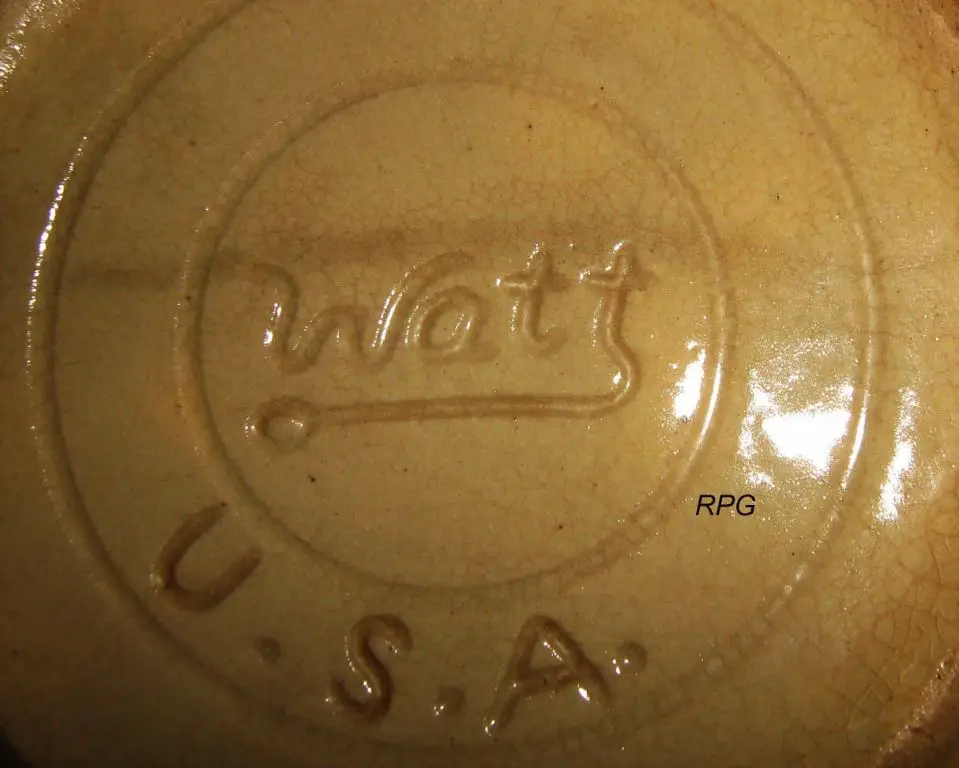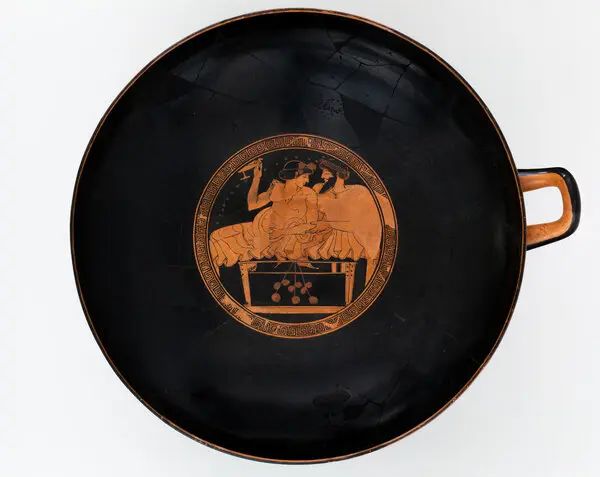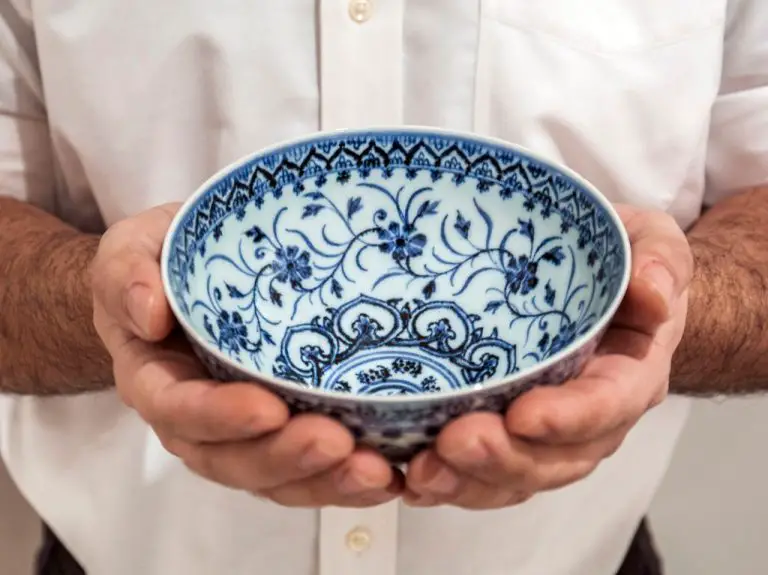Is Mccoy Pottery Always Marked Mccoy?
McCoy pottery has a long and rich history as one of America’s most prolific pottery manufacturers. The company was founded as the Nelson McCoy Sanitary Stoneware Company in Roseville, Ohio in 1910 by J.W. McCoy. It operated for over 80 years under various names like Brush-McCoy and Nelson McCoy before closing in 1990 [1].
Throughout its history, McCoy produced utilitarian stoneware items like jugs, crocks, and vases as well as more decorative art pottery and figurines. At its peak in the 1940s-1960s, McCoy was producing over 1,000 different items each year. Many of their mid-century ceramic lines like Cookie Jars and Planters are now highly collectible [2].
Common McCoy Markings
McCoy pottery produced utilitarian stoneware starting in the early 1900s, so some of its earliest pieces from 1910-1915 have no markings at all according to the McCoy Pottery Collectors Society. The company soon started marking pieces with just a simple “USA” stamp.

In 1925, McCoy began using the stylized “Ulcers” mark, which looks like a stacked MU. This mark was used until 1933. Pieces like mixing bowls and flower pots often had just this Ulcers mark and no McCoy name.
Starting in the 1930s, McCoy started using the block letter M mark. This simple letter M was stamped on many lines through the 1950s. Some pieces had only this block M, while others also included the McCoy name.
In 1938, McCoy introduced its popular Gardenware line. These planters and flower pots featured the McCoy name and logo – a circle with McCoy written in a ribbon banner underneath. This marked circle logo was used well into the 1970s on various McCoy lines.
Some other common McCoy markings to look for include the McFluer flower logo, used 1965-1973, the stylized Mc script logo introduced in 1968, and the oval McCoy banner logo that debuted in 1975.
Unmarked McCoy Pieces
Some authentic McCoy pottery pieces may be unmarked, without the standard McCoy backstamp or markings. There are several reasons for this:
Certain low-end or outsourced McCoy lines did not include the McCoy mark, as the company wanted to distance the brand from lower quality wares (Source). Pieces produced in the 1960s and later were more likely to exclude markings.
During times of high production demand, shortcuts may have been taken, with some pieces skipping the marking process. Earthenware pieces in particular were sometimes left unmarked (Source).
In rare cases, the original McCoy mark may have worn off over time due to cleaning, chipping, or crazing.
So while most vintage McCoy pieces feature a backstamp, mark, or signature, some authentic unmarked pieces do exist.
How to Identify Unmarked McCoy
Identifying unmarked McCoy pottery can be challenging but is possible by looking for several key characteristics:
Examine the bottom for mold numbers – McCoy often molded numbers into the underside of pieces which can help identify the pattern. Numbers like 502, 705, and 315 correspond to specific McCoy patterns.
Look for distinctive McCoy shapes and styles – McCoy introduced many innovative shapes like bulbous vases, swirled cookie jars, and planters with decorative cutouts. Recognizing uniquely McCoy silhouettes can aid identification.
Inspect the clay color and texture – McCoy clay is smooth and thin, ranging from bright white to pale pink or gray. The glaze often appears glassy with pooling in crevices.
Consider decorative motifs – Common McCoy motifs include flowers like violets and daisies, geometric zigzags, braided edges, and art deco stylized plants.
Study the bottom glaze – McCoy dipped just the bottom 1/4 inch of pieces in clear glaze leaving the bare clay exposed. This unglazed bottom ring is indicative of McCoy.
Compare to McCoy catalogs – Finally, cross-checking undocumented pieces against old McCoy catalogs can conclusively match shapes and patterns.
McCoy Production Changes
Over the many decades of McCoy pottery production, the company evolved its production methods and styles to adapt to changing consumer tastes and demands. In the early years, from 1848-1910, McCoy Pottery focused on producing utilitarian stoneware, created from local clay sources in Ohio using labor-intensive methods like salt glazing.
According to the McCoy Pottery Collectors Society, when J.W. McCoy took over the company in 1910, he shifted production towards more decorative and ornate styles that were popular in the early 20th century (Source). This included developing bright, glossy glazes and establishing new decorative lines like Artcraft and Cookie Jars.
As labor costs rose and machine mass production became more viable in the 1920s-1930s, McCoy invested in more efficient equipment and production methods. This allowed them to produce higher quantities of pottery while reducing costs and labor. Famous lines like Cookies Jars, Planters, and Vases took advantage of assembly line techniques. The stoneware clay also transitioned to easier to work with earthenware formulations.
By the 1950s-60s, McCoy was fully immersed in making affordable, mass-produced home decor items and figurines using efficient production methods. This allowed the prices to stay low while still delivering the popular styles and designs the market demanded. However, competition from even cheaper foreign imports led to McCoy’s decline and eventual purchase by Designer Accents in 1967.
Popular McCoy Lines
Some of the most popular and valuable McCoy pottery lines include:
- Brush McCoy – This line featured hand-painted floral motifs and brushwork. It is one of the most collectible McCoy lines, with pieces selling for hundreds of dollars.
- Cookie Jar – McCoy produced over 400 different cookie jar designs between the 1930s-1970s. Popular ones depict animals, people, structures, and vehicles.
- Planter – McCoy planters came in a variety of glazes, shapes, and sizes. Collectors seek out rare and unique planter pieces.
- Southwind – Launched in the 1950s, Southwind featured thin walls, drippy glazes, and unique shapes. It remains popular with collectors today.
- Lilac – Introduced in 1915, the Lilac line featured its signature purple-blue glaze. It was produced for over 50 years.
- Jardinière – These classic decorative planters were produced from the 1910s-1930s. The glazes and colors make them valuable finds.
- Pie Plate – McCoy pie plates were produced from the 1930s-1960s. Collectors seek out the ones with intricate designs and glazes.
Some of the rarest and most unique McCoy pieces can sell for upwards of $10,000 at auction. Even more common pieces in good condition can fetch $100 or more.
Authenticating Suspected McCoy
Verifying if an unmarked piece of pottery is authentic McCoy can be challenging. Here are some tips from experts:
Examine the clay body. Genuine McCoy pottery has an off-white, ivory-colored clay that is smooth and finely potted. Fakes may have a gritty texture or grayish tint.
Look at the glaze. Authentic unmarked McCoy pieces will have a satiny glaze, often with a slight orange peel texture. The glaze should never appear bubbly or bumpy.
Pay attention to details like the mold seams, color variation, and crazing patterns, which can help date the item. Reproductions often lack these subtleties.
Research the shape and pattern. Unmarked vintage McCoy pieces will resemble cataloged examples. Fakes are unlikely to match recorded McCoy forms.
Consult with collectors online through forums like McCoy Pottery Collectors Society. Experienced McCoy enthusiasts can help authenticate pieces.
Take detailed photos and compare to reference materials. Resources like antique guides and price lists contain images to match unmarked McCoy against.
McCoy Reproductions
While vintage McCoy pottery is highly collectible, various companies have produced McCoy reproductions over the years that resemble the original lines. According to the McCoy Pottery Collector’s Society, over 60 McCoy reproduction pieces have been identified.
Some of the most prolific McCoy reproduction makers include Lefton China, American Ceramic Products, and W.S. George. These companies produced miniatures and full-size versions of popular McCoy lines like Cookie Jars and Planters in the 1970s-1990s.
There are a few ways to distinguish newer McCoy reproductions from vintage pieces:
- Check for modern McCoy marks – reproductions will often have “McCoy” marked differently than vintage markings.
- Inspect quality and color – reproductions sometimes have more muted colors and less crisp designs.
- Examine the bottom for lines that go through the glaze – a sign it was made with modern molding techniques.
- Research the item online – join collector groups to compare markings and styles.
While reproductions may look similar, vintage McCoy will always command higher values for knowledgeable collectors.
McCoy Pottery Values
The value of McCoy pottery pieces depends on several factors including age, rarity, condition, markings, and design. Some of the key considerations are:
Age – Older pieces from the 1910s-1930s tend to be the most valuable. Pieces from the 1950s and 1960s also have good value.
Markings – Earlier pieces marked with the McCoy lion mark, USA, or Brush-McCoy command higher prices than later unmarked pieces or those with the block M mark.
Rarity – Harder to find shapes, unusual glazes, and special editions have higher collectibility. For example, rare variations like peach or pink McCoy pieces tend to fetch higher prices.
Condition – McCoy in excellent, mint condition brings substantially more value versus damaged or well-worn pieces.
Design – More ornate, hand-painted, or bas relief designs are generally more desirable than basic shapes and patterns.
Some of the most valuable McCoy pottery includes artwares, vases, cookie jars, and planters in the Peachblow, Craftwood, and Carnival glaze lines. Rare bulbous vase forms can bring over $1,000. More common kitchenware pieces sell for $20-50 in good condition.
Conclusion
In summary, McCoy pottery is not always marked. Many authentic vintage McCoy pieces lack any markings due to changes in the company’s production over time. Identifying unmarked McCoy requires looking at distinguishing characteristics like the color, glaze, patterns, shapes, mold seams, bottom markings, and quality. Expertise is needed to confidently authenticate unmarked McCoy pieces. While some reproductions exist, genuine vintage McCoy remains collectible and valuable on the secondary market. This overview provides key insights into determining if an unmarked pottery piece is likely a true vintage McCoy original.


